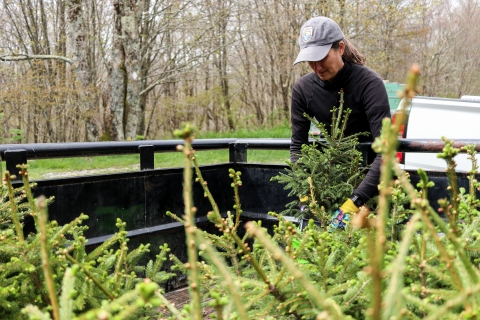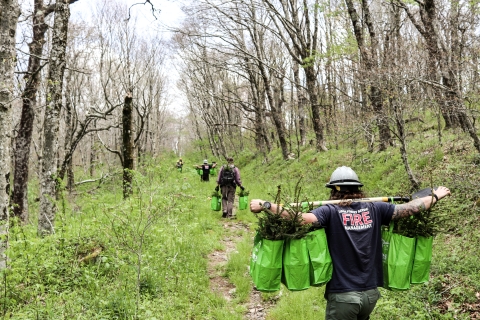At some point in the mid-20th century, a hemlock tree was loaded onto a cargo ship in Asia and shipped to the eastern United States. Somewhere on that hemlock tree was a tiny insect, the hemlock woolly adelgid. The adelgids on this ship were likely native a region of southern Japan.
That insect, catching a ride on that ship is why, seventy years later, a man who the U.S. Army once taught to speak Arabic, and a woman who once helped create the weather forecast for space shuttle launches, found themselves in an isolated corner of east Tennessee planting trees so an endangered flying squirrel wouldn't run out of truffles.
The man was Christian Bartow, and the woman was Karla Quast, each living the latest chapter in their adventurous lives - Christian as a wildland fire apprentice for the U.S. Forest Service, and Karla as an administrative assistant for the U.S. Fish and Wildlife Service. They were two of the two dozen or so people - from federal wildlife biologists to college volunteers and interns - who turned out on this day to help plant trees.
The squirrel is the endangered Carolina northern flying squirrel, found only at the highest elevations of southern Appalachia. Unlike its more common cousin, the ubiquitous gray squirrel, the Carolina northern flying squirrel doesn't eat acorns or steal from your bird feeder. It eats a fungus - a truffle - that grows among the roots of conifer trees. In this corner of Tennessee, the very edge of Cherokee National Forest, just off the scenic Cherohala Skyway (Cherohala = Cherokee + Nantahala, the two National Forests this scenic road traverses), those truffles have grown amongst the roots of eastern hemlock trees. However, the hemlock woolly adelgid, which made its way to Southern Appalachia in the early 00's, attacks and kills hemlock trees. The hemlock trees die, the squirrel's food disappears. The squirrel's food disappears, the squirrel gets closer to extinction.
However, the slow disappearance of eastern hemlock from this spot in the Unicoi Mountains coincided with the rise of efforts to restore red spruce trees at high-elevation areas across southern Appalachia. Like the hemlock, the spruce trees provide habitat for the squirrel's fungus to grow. And also like the hemlock, red spruce has suffered setbacks, though nearly a 100 years earlier when industrial-scale logging and catastrophic wildfires severely knocked back the extent of spruce forests and altered the soil such that natural recolonization became nearly impossible on any timescale measured in years or even decades. Today, multiple agencies, non-profits, and individuals are working to restore spruce, including growing hundreds of spruce in nurseries, then planting them in areas ripe for restoration.
Coordinated by the Service's Sue Cameron and the Forest Service's Philip Earhart, on this May, 2021 day at Whigg meadow, 200 red spruce trees, raised at Southern Highlands Reserve were pulled from the broader spruce restoration effort and planted as a replacement for the dying hemlock...the hope and expectation being that the fungus that nourishes the endangered Carolina flying squirrel will flourish amid the roots of the spruce trees, and the squirrels will continue to thrive here. The trees were raised at Southern Highlands Reserve, a non-profit arboretum and research center growing trees for the red spruce restoration effort.








